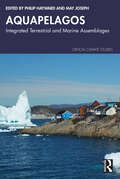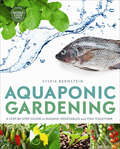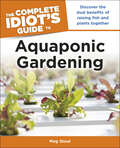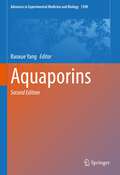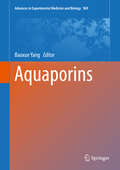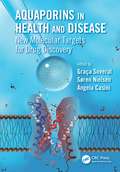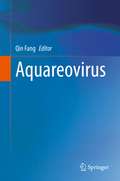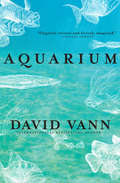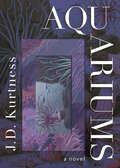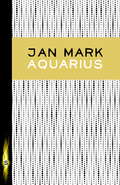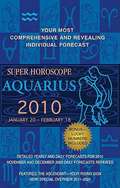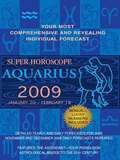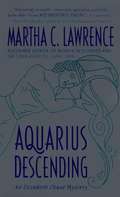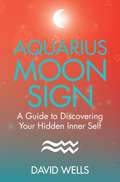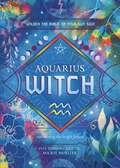- Table View
- List View
Aquanomics: Water Markets and the Environment (Independent Studies In Political Economy Ser.)
by Randy T. Simmons B. Delworth GardnerWater is becoming increasingly scarce. If recent usage trends continue, shortages are inevitable. Aquanomics discusses some of the instruments and policies that may be implemented to postpone, or even avoid, the onset of water crises. These policies include establishing secure and transferable private water rights and extending these rights to uses that traditionally have not been allowed, including altering in-stream flows and ecosystem functions. The editors argue that such policies will help maximize water quantity and quality as water becomes scarcer and more valuable. Aquanomics contains many examples of how this is being accomplished, particularly in the formation of water markets and market-like exchanges of water rights.Many observers see calamity ahead unless water supplies are harnessed and effectively conserved, and unless water quality can be improved. It is also clear that declining water quality is a serious problem in much of the world, as increasing human activities induce high levels of water degradation. Those who voice these concerns, argue the contributors to this volume, fail to consider the forces for improvement inherent in market political-economic systems that can address water issues. The contributors see water quality in economically advanced countries as improving, and they believe this establishes the validity of market-based approaches.
Aquapelagos: Integrated Terrestrial and Marine Assemblages (Critical Climate Studies)
by Philip Hayward and May JosephAquapelagos is a cross-disciplinary volume that is geared to a general undergraduate and non-specialist readership while also being rigorous and theoretically exciting for doctoral and advanced researchers of climate and ocean studies. It foregrounds marine-terrestrial assemblages as philosophical, navigational, and knowledge-making interfaces.Drawing on ethnographic, geographic, architectural, sociological, and scientific methodogies, Aquapelagos sheds light on varied approaches, dialogues, and responses to the catastrophic and impending futures unfolding across waterfronts from the Andaman Islands, Maldives, and Indonesia to the Grand Banks and the Juan Fernandez Islands. It delves into pressing issues of human interrelations with aquatic environments, ocean volatility, ocean toxicity, flooding, inundation, mitigation, rising seas, and climate adaptation in interdisciplinary and comparative global terms. Within the conceptual framework of the aquapelago, the contributors to this volume explore aspects of integrated terrestrial and marine assemblages that enhance our understanding of the impact of global climate change and related rising sea levels on diverse planetary ecologies and the societies that depend on them.The volume will be of interest to scholars, researchers, and students of ethnography, social anthropology, climate action, development studies, public policy, and climate change.
Aquaphotomics for Bio-diagnostics in Dairy: Applications of Near-Infrared Spectroscopy
by Roumiana Tsenkova Jelena MuncanThis book is the result of more than 20 years of experience in working with near-infrared spectroscopy for raw milk analysis. The totality of this work presents extensive possibilities for milk spectral measurements that can be carried out in dairy. Moving beyond the standard milk components such as fat, protein, or lactose, this book presents near-infrared spectroscopy as a method that can also be used in disease diagnostics. The measurements and experimental results presented here are all based on the utilization of usually neglected near-infrared regions—regions with strong absorbance of water. The author has found the water – light interaction discussed to be an immensely rich source of information, not only on milk composition but also on the physiological status of the animals involved. A special section of the book is dedicated to exploration of potential interfering factors that may influence the analysis and contribute to the robustness of the models. The research described in this book served as a basis for the development of the novel discipline aquaphotomics and is of interest to anyone working in this field.
Aquaponic Gardening: A Step-by-Step Guide to Raising Vegetables and Fish Together (Mother Earth News Books for Wiser Living)
by Sylvia Bernstein&“I have always wanted to figure out how to do sustainable aquaculture in the context of my home garden. Finally I&’ve got the book to help me do it.&” —Paul Greenberg, New York Times–bestselling author, Four Fish: The Future of the Last Wild Food Aquaponics is a revolutionary system for growing plants by fertilizing them with the waste water from fish in a sustainable closed system. A combination of the best of aquaculture and hydroponics, aquaponic gardening is an amazingly productive way to grow organic vegetables, greens, herbs and fruits, while providing the added benefits of fresh fish as a safe, healthy source of protein. On a larger scale, it is a key solution to mitigating food insecurity, climate change, groundwater pollution and the impacts of overfishing on our oceans.Aquaponic Gardening is the definitive do-it-yourself home manual, focused on giving you all the tools you need to create your own aquaponic system and enjoy healthy, safe, fresh and delicious food all year round. Starting with an overview of the theory, benefits and potential of aquaponics, the book goes on to explain: System location considerations and hardware components The living elements—fish, plants, bacteria, and worms Putting it all together—starting and maintaining a healthy system. Aquaponics systems are completely organic. They are four to six times more productive and use 90 percent less water than conventional gardens. Other advantages include no weeds, fewer pests, and no watering, fertilizing, bending, digging, or heavy lifting—in fact, there really is no down side! Anyone interested in taking the next step towards self-sufficiency will be fascinated by this practical, accessible and well-illustrated guide. &“An excellent primer for anyone considering home-scale aquaculture.&” —Peter Bane, publisher, Permaculture Activist and author, The Permaculture Handbook
Aquaponic Gardening: Discover the Dual Benefits of Raising Fish and Plants Together (Idiot's Guides)
by Meg StoutThe Complete Idiot&’s Guide® to Aquaponic Gardening is a comprehensive guide to aquaponic gardening, from choosing a setup to selecting fish and vegetables. In addition to everything one needs to know to run a healthy aquaponic garden and care for both the vegetables and fish, there are step-by-step plans with photos for building different size systems. The expert author fully explains how to garden indoors and how to resize and move a garden inside or outside, depending on the season, to produce an abundant supply of edible, organically raised vegetables and fish.
Aquaponics Food Production Systems: Combined Aquaculture and Hydroponic Production Technologies for the Future
by Simon Goddek Alyssa Joyce Benz Kotzen Gavin M. BurnellThis open access book, written by world experts in aquaponics and related technologies, provides the authoritative and comprehensive overview of the key aquaculture and hydroponic and other integrated systems, socio-economic and environmental aspects. Aquaponic systems, which combine aquaculture and vegetable food production offer alternative technology solutions for a world that is increasingly under stress through population growth, urbanisation, water shortages, land and soil degradation, environmental pollution, world hunger and climate change.
Aquaporins (Advances in Experimental Medicine and Biology #1398)
by Baoxue YangThis book provides a state-of-the-art report on our current understanding of aquaporins and the future direction of the field. Aquaporins (AQPs) are a group of water-channel proteins that are specifically permeable to water and other small molecules, such as glycerol and urea. To date thirteen water-channel proteins (AQP0 – AQP12) have been cloned and the mechanisms and physiological functions of water transport across biological membranes have long been the subject of interest. Recent advances in the molecular biology and physiology of water transport have yielded new insights into how and why water moves across cell membranes, and studies on aquaporin knockout mouse models suggest that aquaporins are involved in the development of some diseases and they may be useful targets of research into selective-inhibitor drugs. By focusing on the advances made over the last 30 years in the biophysics, genetics, protein structure, molecular biology, physiology, pathophysiology and pharmacology of aquaporins in mammalian cell membranes, this book provides novel insights into further mechanisms and the physiological significance of water and some small molecule transport in mammals in order to stimulate further research in new directions.In the second version, fourteen chapters will be updated base on the most recent research articles. Ten new chapters will be added.
Aquaporins (Advances in Experimental Medicine and Biology #969)
by Baoxue YangThis book provides a state-of-the-art report on our current understanding of aquaporins and the future direction of the field. Aquaporins (AQPs) are a group of water-channel proteins that are specifically permeable to water and other small molecules, such as glycerol and urea. To date thirteen water-channel proteins (AQP0 - AQP12) have been cloned and the mechanisms and physiological functions of water transport across biological membranes have long been the subject of interest. Recent advances in the molecular biology and physiology of water transport have yielded new insights into how and why water moves across cell membranes, and studies on aquaporin knockout mouse models suggest that aquaporins are involved in the development of some diseases and they may be useful targets of research into selective-inhibitor drugs. By focusing on the advances made over the last 20 years in the biophysics, genetics, protein structure, molecular biology, physiology, pathophysiology and pharmacology of aquaporins in mammalian cell membranes, this book provides novel insights into further mechanisms and the physiological significance of water and some small molecule transport in mammals in order to stimulate further research in new directions.
Aquaporins (Advances in Experimental Medicine and Biology Series #1398)
by Baoxue Yang<p>This book provides a state-of-the-art report on our current understanding of aquaporins and the future direction of the field.<p> <p>Aquaporins (AQPs) are a group of water-channel proteins that are specifically permeable to water and other small molecules, such as glycerol and urea. To date thirteen water-channel proteins (AQP0 – AQP12) have been cloned and the mechanisms and physiological functions of water transport across biological membranes have long been the subject of interest. Recent advances in the molecular biology and physiology of water transport have yielded new insights into how and why water moves across cell membranes, and studies on aquaporin knockout mouse models suggest that aquaporins are involved in the development of some diseases and they may be useful targets of research into selective-inhibitor drugs.<p> <p>By focusing on the advances made over the last 30 years in the biophysics, genetics, protein structure, molecular biology, physiology, pathophysiology and pharmacology of aquaporins in mammalian cell membranes, this book provides novel insights into further mechanisms and the physiological significance of water and some small molecule transport in mammals in order to stimulate further research in new directions.<p> <p>In the second version, fourteen chapters will be updated base on the most recent research articles. Ten new chapters will be added.<p>
Aquaporins in Health and Disease: New Molecular Targets for Drug Discovery
by Angela Casini Graça Soveral S0ren NielsenSince the discovery of Aquaporin-1 (AQP1) as a water channel, many studies have revealed the importance of aquaporins in mammalian physiology and pathophysiology as well as plant and microbial biology. The studies have also shown aquaporins as potential drug targets and targets for improving crop properties.Written by an international group of contributors at the forefront of the field, Aquaporins in Health and Disease: New Molecular Targets for Drug Discovery presents the latest research advances in aquaporins and other major intrinsic protein (MIP) channels. The first section of the book describes the general concepts of aquaporin channel function, genomic research, structure-function analysis of aquaporins and glycerol facilitators, and regulation by gating and trafficking, including yeast aquaporin regulation and function. The second section discusses the physiological and pathophysiological roles of aquaporins in humans and microbes. The final section covers the development of inhibitors of aquaporin function. The book’s epilogue offers future perspectives and directions, mainly in the area of aquaporin-based diagnostics and therapeutics.Stimulating future research on this important protein family, this book facilitates a paradigm shift in the understanding and roles of aquaporin membrane proteins in all biological settings. It encourages scientists to develop novel approaches for the treatment of human diseases based on aquaporin function or dysfunction.
Aquareovirus
by Qin FangAquareoviruses cause infection in bony fish and shellfish and thus, constitute a significant threat to aquaculture industries worldwide. Aquareoviruses, belonging to the family Reoviridae, have genomes consisting of 11 segments of double-stranded RNA contained within a core (T = 1) surrounded by a double-layered icosahedral capsid with a T = 13 symmetry in general. These viruses not only physically resemble mammalian orthoreoviruses, but also show the highest amino acid identity. More than hundred aquareoviruses have been isolated from both saline water and freshwater origins; however, literary sources elucidating aquareovirus biology are very limited. Given the increasing pace of discovery, it is imperative to make a clear, systematic filing of key aspects of aquareoviruses. Therefore, the aim of writing this book is to provide insights into the molecular mechanisms of evolution, pathogenesis, and host response in aquareovirus infection. This book offers a state-of-the-art report on recent discoveries concerning the aquareovirus genome evolution, gene encoded protein functions, and pathogenesis by comparison with its sister genus Orthoreovirus, including avian and mammalian reoviruses. It mainly focuses on advances made over the past 30 years in research on the general and molecular biology, protein structure and function, infection and replication, epidemiology and diagnosis, immunological prevention and medical treatment, and host antiviral immunity against aquareovirus infection. This book will help curious graduate students or interested researchers acquire an overall picture of aquareovirus infection and pathogenesis, as well as yield benefits in fisheries to better prevent and control diseases caused by aquareovirus infection.
Aquarium
by Cynthia Alonso<P>A girl ventures to the water's edge, dreaming of a new friend. And, just like that, a beguiling red fish leaps into her life. But is friendship a sea these two can navigate together? <P>From debut Argentinian author-illustrator Cynthia Alonso comes a wordless picture book about the timeless beauty of nature, the transcendent power of connection, and the importance of letting go.
Aquarium
by David VannTwelve year old Caitlin lives alone with her mother—a docker at the local container port—in subsidized housing next to an airport in Seattle. Each day, while she waits to be picked up after school, Caitlin visits the local aquarium to study the fish. Gazing at the creatures within the watery depths, Caitlin accesses a shimmering universe beyond her own. When she befriends an old man at the tanks one day, who seems as enamored of the fish as she, Caitlin cracks open a dark family secret and propels her once-blissful relationship with her mother toward a precipice of terrifying consequence.<P><P> In crystalline, chiseled yet graceful prose, Aquarium takes us into the heart of a brave young girl whose longing for love and capacity for forgiveness transforms the damaged people around her. Relentless and heartbreaking, primal and redemptive, Aquarium is a transporting story from one of the best American writers of our time.
Aquarium
by David Vann"Like Melville, Faulkner, and McCarthy, Vann is already one of the great ones of American literature."-ABC(Spain)"Vann’s prose is as pure as a gulp of water from an Alaskan stream.”-Financial TimesDavid Vann’s dazzling debut Legend of a Suicide was reviewed in over a 150 major global publications, won 11 prizes worldwide, was on 40 "best books of the year” lists, and established its author as a literary master. Since then, Vann has delivered an exceptional body of work, receiving, among others, best foreign novel in France and Spain (France’s Prix Medicis Etranger, Spain’s Premi Llibreter), a California Book Award, and the mid-career St. Francis College Literary Prize. Aquarium, his implosive new book and first to be published by Grove, will take Vann to a wider audience than ever before.Twelve year old Caitlin lives alone with her mother-a docker at the local container port-in subsidized housing next to an airport in Seattle. Each day, while she waits to be picked up after school, Caitlin visits the local aquarium to study the fish. Gazing at the creatures within the watery depths, Caitlin accesses a shimmering universe beyond her own. When she befriends an old man at the tanks one day, who seems as enamored of the fish as she, Caitlin cracks open a dark family secret and propels her once-blissful relationship with her mother toward a precipice of terrifying consequence.In crystalline, chiseled yet graceful prose, Aquarium takes us into the heart of a brave young girl whose longing for love and capacity for forgiveness transforms the damaged people around her. Relentless and heartbreaking, primal and redemptive, Aquarium is a transporting story from one of the best American writers of our time.
Aquarium: (aquarium Books For Kids, Picture Book About Marine Animals, Nature Books)
by Cynthia AlonsoA girl ventures to the water's edge, dreaming of a new friend. And, just like that, a beguiling red fish leaps into her life. But is friendship a sea these two can navigate together? From debut Argentinian author-illustrator Cynthia Alonso comes a wordless picture book about the timeless beauty of nature, the transcendent power of connection, and the importance of letting go.
Aquarium: A Novel
by Yaara ShehoriA debut novel following two sisters, both deaf and raised in seclusion by deaf parents, and the shattering consequences that unfold when that isolation comes to an end.Sisters Lili and Dori Ackerman are deaf. Their parents—beautiful, despondent Anna; fearsome and admired Alex—are deaf, too. Alex, a scrap metal collector and sometime prophet, opposes any attempt to integrate with the hearing; to escape their destructive influence, the girls are educated at home. Deafness is no disability, their father says, but an alternative way of life, preferable by far to that of the strident, hypocritical hearing. Living in a universe of their own creation, feared by and disdainful of the other children on their block, Lili and Dori grow up semi-feral. Lili writes down everything that happens—just the facts. And Dori, the reader, follows her older sister wherever she goes. United against a hostile and alien world, the girls and their parents watch the hearing like they would fish in an aquarium. But when the hearing intrude and a devastating secret is revealed, the cracks that begin to form in the sisters’ world will have consequences that span the rest of their lives. Separated from the family that ingrained in them a sense of uniqueness and alienation, Lili and Dori must relearn how to live, and how to tell their own stories.Sly, surprising, and as fierce as its protagonists, Yaara Shehori’s Aquarium is a stunning debut that interrogates the practice of storytelling—and storyhearing.
Aquariums
by J.D. KurtnessAn intimate yet wide-sweeping story of a marine biologist working to save ocean ecosystems from climate change.With the world’s oceans ravaged by climate change, Émeraude, a young marine biologist, works to preserve aquatic ecosystems by recreating them for zoos. When her work earns her a spot aboard a research vessel with an extended mission in the Arctic, it is the inescapable draw of the ocean that will save her when the world she leaves behind is irrevocably changed.Stories of Émeraude’s ancestors — a young sailor abandoned at birth, a conjuror who mixes potions for her neighbours, a violent young man who hides in the woods to escape an even more violent war, and a talented young singer born to a mother who cannot speak — weave their way through her intimate reflections on a modest life, unknowingly shaped by those who came before.A RARE MACHINES BOOK
Aquarius
by Jan MarkViner lives in a land that constantly floods - his skill as a water diviner has lead to ridicule. But when he is kidnapped all this changes. His murderous captors force him to work for them in their drought-stricken country - and to challenge the Rain-King whose failure to provide the necessary rainfall is sorely trying all those around him. But instead of ridiculing the King, Viner befriends him - perhaps more ... Aquarius is a deeply humane story of power, manipulation, ambition, and burgeoning sexuality. Viner is a complex character - easy to like and despise in equal measure. His story will not easily be forgotten.
Aquarius
by Jan MarkViner lives in a land that constantly floods - his skill as a water diviner has led to ridicule. But when he is kidnapped all this changes. His murderous captors force him to work for them in their drought-stricken country - and to challenge the Rain-King whose failure to provide the necessary rainfall is sorely trying all those around him. But instead of ridiculing the King, Viner befriends him - perhaps more ... Aquarius is a deeply humane story of power, manipulation, ambition, and burgeoning sexuality. Viner is a complex character - easy to like and despise in equal measure. His story will not easily be forgotten.
Aquarius (Super Horoscopes #2010)
by Margarete BeimThe most comprehensive day-by-day predictions on the market. Every day, people depend on their horoscopes for a glimpse of what's to come-and Berkley's Super Horoscopes offer the predictions that they're searching for. With special sections on the history and uses of astrology, these updated books will show readers exactly what the future holds for them. Each sign includes: ? Detailed yearly and daily forecasts ? Rising signs and rising times ? Lucky numbers ? Cusp born and cusp dates ? Signs of the zodiac ? Character analysis ? Love, romance, and marriage compatibility guide ? Moon tables ? Planting and fishing guides ? Influence of the moon and planets ? Famous personalities ? November and December 2009 daily forecasts repeated
Aquarius (Super Horoscopes #2011)
by Margarete BeimThe most comprehensive day-by-day predictions on the market. Every day, people depend on their horoscopes for a glimpse of what's to come-and Berkley's Super Horoscopes offer the predictions that readers are searching for. With special sections on the history and uses of astrology, these updated books will reveal exactly what the future holds. Each sign includes: ?Detailed yearly and daily forecasts ?Rising signs ?Lucky numbers ?Cusp born and cusp dates ?Signs of the zodiac ?Character analysis ?Love, romance, and marriage compatibility guide ?Moon tables ?Planting and fishing guides ?Influence of the Sun, Moon, and planets ?Famous personalities
Aquarius Descending
by Martha C. LawrenceIn this breakout book of an Edgar-nominated series featuring a paranormal investigator, Elizabeth Chase puts her psychic detecting skills to the ultimate test when she infiltrates the inner circle of a dangerous cult and finds a seductive heart of darkness where the mind is the first to die.
Aquarius Moon Sign: A Guide to Discovering Your Hidden Inner Self
by David WellsWhat if you had a hidden inner self you never knew about? This key to your horoscope is the moon sign!Many people understand their sun sign, but few realise that the key to their astrological insight is unlocked by a deeper truth: the moon sign. Your moon sign is a reflection of your secret inner self, and has important messages to aid you in your career, love life and ultimately your destiny. Understanding the secret power of your moon sign is now easier than ever with this short guide. Specially aligned for your individual moon sign of Aquarius, this book has been carefully charted and prepared by astrology expert David Wells, whose advice will help you quickly understand: • Your overall astrological outlook for 2014• How your moon sign co-operates, or interferes with, your sun sign in 2014• How your moon sign affects your romantic life, your work life and your spiritual life.You won't want to overlook this important part of your astrological make up in the coming year with this brilliant new series! Visit moon-sign-calculator.com to calculate your moon sign and find out yours today!
Aquarius Witch: Unlock the Magic of Your Sun Sign (The Witch's Sun Sign Series)
by Mickie Mueller Ivo DominguezWitchcraft to Celebrate Your Innovative & Independent Self Enhance your magical practice and personal development with the power of your Aquarius Sun sign. Ivo Dominguez, Jr. and Mickie Mueller share what strengths and challenges your sign brings to both witchcraft and everyday life. Featuring recipes, exercises, stories, rituals, and spells from the authors and a host of Aquarius contributors, this book teaches you how to best connect with your sign’s energy, manage your power, cleanse and shield yourself, tailor-fit magical workings to your sign, and more.Contributors to this volume:Silver Daniels • Danielle Dionne • Robin Fennelly • Kieran • Alexandra Nic Bhé Chuille • Sandra Santiago • Dawn Aurora Hunt • Sandra Kynes
Aquarius: The Art of Living Well and Finding Happiness According to Your Star Sign
by Sally KirkmanYou are an Aquarius. You are the innovative thinker and social agent of the zodiac.The signs of the zodiac can give us great insight into our day-to-day living as well as the many talents and qualities we possess. But in an increasingly unpredictable world, how can we make sense of them? And what do they mean? This insightful and introductory guide delves deep into your star sign, revealing unique traits and meanings which you didn't know. Along the way, you will discover how your sign defies your compatibility, how to improve your health and what your gifts are. ***The Pocket Astrology series will teach you how to live well and enhance every aspect of your life. From friendship to compatibility, careers to finance, you will discover new elements to your sign and learn about the ancient art of astrology. Other books in the series include: Aries, Taurus, Gemini, Cancer, Leo, Virgo, Libra, Scorpio, Sagittarius,Capricorn, Aquarius, Pisces

